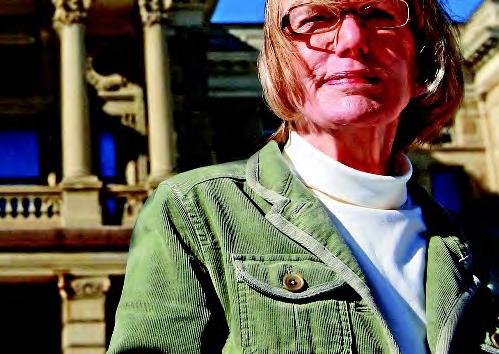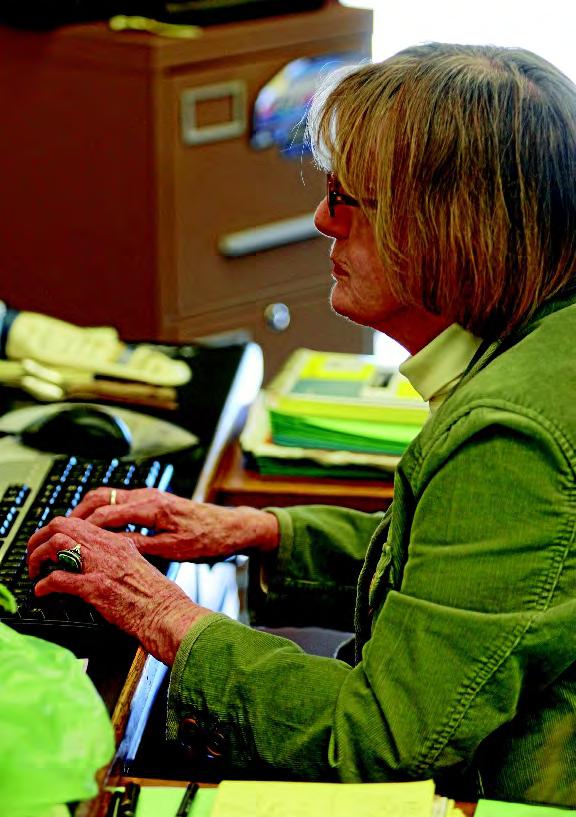
5 minute read
Joan Barron
BARRON BROKE GROUND IN LENGTHY CAREER

Advertisement

No other reporter has been inducted into WPA’s Hall of Fame




GAYLE M. IRWIN
For the Star-Tribune
Working for the Casper Star-Tribune for nearly 50 years earned Joan Barron a place in Wyoming journalism history. In January, she became the first reporter, and just the third woman, inducted into the Wyoming Press Association’s Hall of Fame.
“It’s extra-special that a pure reporter was inducted,” said Bruce McCormack, former editor and publisher of the Cody Enterprise. “There’s no one else like that … and that it was her is completely appropriate. There’s nobody who has stood the test of time like she has, nobody that has been on the state government capital beat like her.”
McCormack worked with Barron in Cheyenne in 1977.
“I was just a cub reporter, and she was already a veteran,” he said. “She’s thoughtful, methodical and especially careful, accurate and clever — that and a lot more. She’s really an interesting study in how influential, how well-read and how respected you can become when you stay on a beat for that long and do the kind of great work she’s done, so consistently for so long.”
That longevity created a bevy of stories.
“She has been present, and she observed and reported on the history of this state for so long — I think she’s probably been read by three generations of most families in Wyoming,” said Rob Hurless, former publisher of the Star-Tribune. “She produced an incredible amount and body of work, and it was time she was recognized. I don’t think it’s going to be easily duplicated.”
“If you’d pull together a dozen publishers and editors from around Wyoming who’d talk about all the top reporters they’ve known for the last 50 years, there would be no one who could refer to somebody that was better than Joan,” McCormack added.
Hurless and former editor Dan Neal informed her of the induction, Barron said.
“I was absolutely stunned — I had no idea it was going to happen,” she said.
Born in Iowa and trained in health care, Barron’s reporting career began in 1966 while she and her family lived in Rock Springs.
FILE, STAR-TRIBUNE Longtime Casper-Star Tribune capital bureau reporter Joan Barron works at her desk inside the Wyoming Capitol on Feb. 26, 2014 in Cheyenne.

“I started when the paper first went statewide,” she recalled. “I was a correspondent. At that time, they had people all over the state.”
For three years she covered the Rock Springs area, and then she and her family moved to Cheyenne. Her then-husband worked for the highway department and was transferred. That move opened a new opportunity for her.
“The day we were leaving, the editor called me and said there was going to be an opening in the state house and was I interested,” Barron said. “I said, ‘Well, I guess so.’”
For the next 45 years, she covered politics, federal and state court cases, and other assignments she was given.
“It was a big job, (but) I found it fascinating,” she said.
One major court case she covered gained substantial notoriety. Ed Cantrell, former Rock Springs director of public safety, was accused of murdering undercover police officer Michael Angel Rosa in July 1978. Rosa was scheduled to testify before a grand jury regarding vice and corruption in Rock Springs two days after he was shot. Cantrell, who alleged Rosa was reaching for a weapon, was acquitted of the crime.
Even though she covered similar cases, Barron said, “I enjoyed covering all the legislative sessions. When I started, it was the cusp of the boom. They were passing very important pieces of legislation, like the Mineral Trust Fund. They did an awful lot in a short period of time.”
She admitted following and reporting on the legislature could be “boring” at times, especially following the status of bills.
“It was a long, tedious process, but I found it fascinating,” she said.
During her tenure as the newspaper’s capital reporter, Barron took courses and received her bachelor’s degree in journalism. Her interviewing style became famous among those who knew and worked with her.
“She’d asked the question and then she would wait,” Hurless said. “They’d answer the question, and instead of responding, she would stay quiet. In that dead air, they would start talking again and usually divulge more than they wanted to. She was able to get stories that were well-guarded, stories that other reporters couldn’t get.”
McCormack agreed.
“Joan would ask the question in such a short, succinct way — like 10 words — and then she’d just clamp her jaw shut,” he said. “It’s almost a law enforcement technique … you let that silence draw them out, and they want to fill that empty space. Joan is the master at that. She would ask this very simple question in this very unassuming way … and then just sit back and not say a word, just let the words come tumbling out of whoever she was interviewing.”
Barron has won several awards for her reporting, including one from the Wyoming League of Women Voters. She attributes her journalism growth and success to Phil McAuley, a former managing editor of the Star-Tribune who hired her to cover the state house. She said he gave her two pieces of advice.
“Write tight and read books,” she said.
She offered similar advice to people exploring career options.
“Read a lot, try different things and go to college,” she said. “If you find a job you love, you’ll be happy.”
She retired as a reporter in 2014, but at more than 90 years of age, she still writes a weekly Sunday column for the newspaper.
“I’m so grateful I found something I really liked,” she said.










